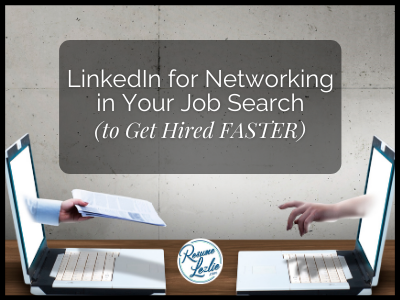Now – more than ever – networking is vital to job search success.
(After you finish here, learn about networking strategies that actually work – and get example networking scripts – in this blog’s companion piece here)
LinkedIn is a great place to build your network – if you use it the right way.
The trouble is, most job seekers don’t. Instead, they’re using it the Wrong Way.
The Wrong Way: log in every once in a while; scroll through your feed; maybe tap ‘Like’ on a couple things (usually not); answer messages (if applicable); log out; repeat monthly.
If you want to elevate yourself above ‘most professionals’, then it’s important you understand how to use LinkedIn the right way in your job search.
The Right Way looks more like: log in regularly; Follow companies, people, and organizations related to your target industry/roles; Like and Comment on posts from those profiles; seek out and maintain meaningful connections; create and share valuable content; repeat daily or multiple times per week.
But again, most job seekers aren’t using Right Way strategies with LinkedIn.
That’s why I centered this blog and its companion piece (over on the RVer Job Exchange) on step-by-step strategies to network, communicate, and use LinkedIn for maximum success in your job search.
Wanna make sure your resume is on point?
Download my 5-Step Action Plan to Write an Interview-Getting Resume.
Why It Matters
Before we get into the specifics, let’s take a look at why it’s important to cultivate your social media for passive professional development.
This is something I’ve been trying to yell from the rooftops for a while now, and if you’ve been following me for any time at all, you’ve probably heard me talk about it at least a little.
You can strategically cultivate your social feeds to show you more helpful, beneficial, and positive content for your professional (and personal) development.
Read that again.
By being mindful about how you spend your time on social media, the pages and people you follow, and the groups you join, you can improve your social feeds and intentionally foster a more productive digital environment for yourself.
It all works like this:
Social media platforms are run by algorithms that, different as they may be, are all driving toward 1 goal: keeping your attention for as long as possible.
Why? Because in an online world, attention is the currency, and social media platforms make their money from advertisers based on how many people are on the platform and for how long.
So, each time you use a social media platform, its algorithm learns from your behavior and alters your feed to show you more of what it thinks you will like – meaning, what it thinks will keep your attention the longest and keep you coming back the most often.
Knowing this, you can be intentional about your usage and leverage the algorithm as a tool to help your feed show you more of the content that is helpful to your life and/or career, and less of anything else.
You still with me?
Good. Now that you have this knowledge, do something with it.
Cultivating Your Feed and Building New Connections
To help you get started on cultivating your LinkedIn profile for your job search, let’s look at who is best for you to connect with, and how or where you can find them.
For the who, that really depends on you and your circumstance. Typically, you want to focus on people you have things in common with, or who have things in common with the person you want to be. (Learn more about this in the companion piece.)
As for the how or where to find the right people to network with – it’s never been easier, thanks to LinkedIn.
LinkedIn Search Bar
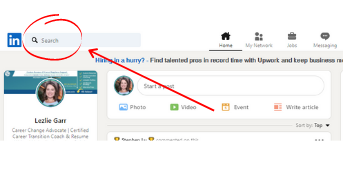
Through this function, you can search for companies, organizations, schools, industries, and groups you may want to start Following.
You can also search for people you know, and even people you don’t know.
The part of this function that’s super beneficial for job seekers is that you can do a kind of cross-search to find new people based on the companies, organizations, schools, etc. they have listed in their profile.
So, if you wanted to start networking with people who work at your ideal company, you could use the search bar, type in the name of the company, and click Search.
When the results come up, you can filter them by several different selections. If you select ‘People’, the results will filter to show you people who have that company listed in their profile.
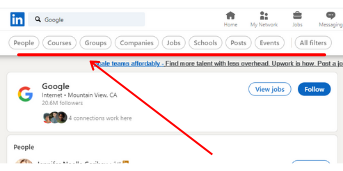
Same thing goes for organizations, schools, job titles, etc. You can put the org / school / job title in the search bar, then filter your results by ‘People’ in order to find people with that thing somewhere in their profile.
LinkedIn Activity
Use your search bar as discussed in the section above to look up people of interest.
When you find someone you might be interested in networking with, click on their profile and scroll down to their Activities section (just before Experience).
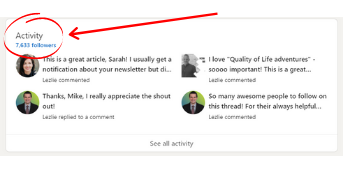
What you’re looking for is someone who is active on LinkedIn.
This section will show you all their public activity on LinkedIn. If this section doesn’t show much activity, or if the activity is months or years old, that means they aren’t very active on, which means they may not be a great connection on this platform.
The goal with this exercise is to find people who are active on LinkedIn, because those are the people who will likely respond to your connection requests, engage with you, and/or become a valuable connection within your network.
Groups
LinkedIn groups have become a powerful way of connecting with people of similar interests, industry, or job function.
Through groups, you can more closely target your message to a particular audience, and you have the
Groups should be chosen based on their relevance to your career- current or intended- skills, and interests.
You will see updates and articles from people in your groups. You can even set your preferences to receive emails whenever a new topic is brought up. This gives you the opportunity to learn new things about your industry, debate and give your opinion on group topics, and interact with others.
By being active in groups, people will begin to recognize you, thus creating bonds that may be useful to one or both of you in the future.
And, it doesn’t have to be a difficult or time-consuming task to complete. Just be diligent about logging onto LinkedIn once or twice a week, checking in with your groups, and commenting a few times. Then, if you find yourself consistently interacting with the same person or people, consider sending a connection request to grow your network.
Organizations
Across nearly every industry, there are professional organizations that have been created to provide professional development, networking opportunities, authority building, and more.
Whatever industry you’re in, use LinkedIn to look for and Follow the professional organizations that exist within that space. If that organization also has an ‘official’ or even ‘unofficial’ Group on LinkedIn, join that, too.
Doing this will help you to interact and engage with other people in the space and build your network from there. Having the commonality of being in the same Group or Following the same organization is a great ice breaker or starting point for an initial message to Connect. (more on Follow vs. Connect in the next section).
Actionable Steps
Follow vs. Connect
Follow and Connect are two options LinkedIn provides for you to engage with and begin seeing more of a particular person’s or page’s content.
When you Follow a person or page, the algorithm will populate (show you) their content in your ‘Feed’. (‘populate’ is tech-speak meaning ‘to show’, and if you’re not sure what a Feed is, I Googled it for you.)
The act of Following is a 1-way function – you can follow any person or page without their express permission, and when you Follow a person or page, you will see their content in your Feed, but they won’t necessarily see your content in their Feed.
When you Connect with a person, it’s a 2-way function. You have to request the Connection, and they can confirm or deny. If they confirm, then the algorithm will populate their content in your Feed as well as populating your content in their Feed.
As a general rule, you should try to Follow people you are genuinely interested in learning from (but not necessarily having a direct relationship with), and Connect with people you are genuinely interested in developing ongoing communications with.
When you connect with someone, especially someone you don’t know or don’t know well, be sure to include a message with your Connection request.
On desktop: click Connect then select Add a Note

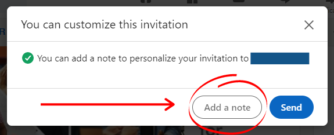
On mobile: do NOT click Connect, instead click More, then select ‘Personalize invite’
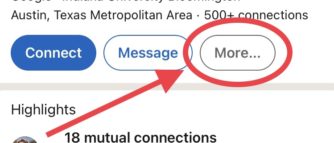
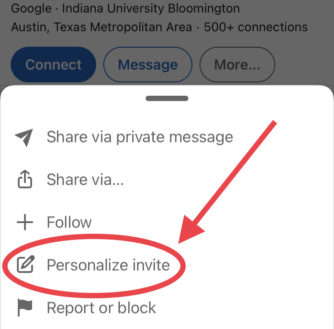
What to say when you connect
This is another area where the LinkedIn Activity section comes in handy, and this is by far one of the most valuable tips I’ve come up with recently regarding LinkedIn + Job Search networking.
This is especially helpful when you find someone new you want to connect with, but you don’t have any common people or experiences you can reference.
Click on that person’s profile, scroll to the Activity section, and click ‘See All Activity’.
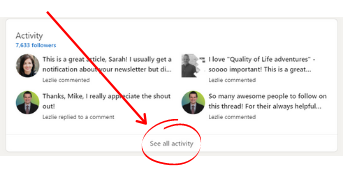
From there, you have the option to filter their activity based on what you want to see.
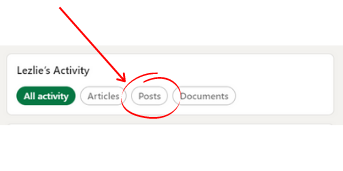
Browse their Activity, and read some of their posts, comments, etc. to look for something you can use to break the ice.
Remember that flattery will get you everywhere, so look or something that really resonates with you, something you like a lot, or something you can compliment them on.
You can also look for commonalities you share, like people you both know, a school you both went to (or a fraternity sorority you were both a part of), an organization you both volunteered for, or an interest your both share.
When reaching out to connect, take the time to send genuine messages that are unique to them, not generic, copy/paste messages, and always show gratitude for any help (or even time) someone gives you.
And always try to be helpful first (or at least flattering, because flattery will get you everywhere) – try to avoid leading with an ‘ask’ for yourself.
Ways to engage
The easiest and least intimidating way to engage with someone is to ‘Like’ a Post or Comment from them. You can also choose other reactions, which I’m sure will change over time but for right now are: Like, Celebrate, Support, Love, Insightful, and Curious.
The next step after Liking is to leave a Comment on something. This is a great way to start developing your ‘voice’ and sharing what you value and find important in your space.
(This is also a great time to begin flattering the people you’re interested in connecting with.)
If someone posts content you feel strongly about and want to support by spreading it even further, you can Share that Post.
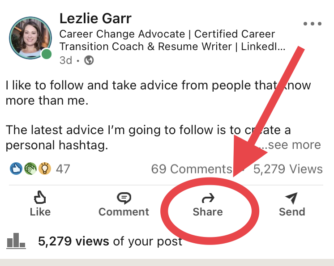
It’s good to include your own commentary when you Share, but you can also Share without typing anything yourself.
You can also Tag people in posts you Share or your own original content (more on original content below), to engage with them on a more direct level.
When it comes Tagging, think of this as a privilege and avoid overusing it. Not only is over-tagging or irrelevant tagging an annoyance to the person/people you’re tagging, the LinkedIn algorithm responds negatively when people you Tag don’t interact, and it will ‘ding’ your content reach and social score.
LinkedIn also provides the option of sending Direct Messages (or DMs) to people. This is another function that is best thought of as a privilege.
By all means DM people with relevant information, but be careful not to abuse the privilege of having direct access to them. Don’t be spammy, or selfish, or rude. Always be kind, helpful, and supportive.
Indirect networking
You can take your engagement a step further by posting your own thoughts, ideas, and opinions as they relate to your career field.
Posts and Articles are a great way to indirectly network on LinkedIn. By Posting your own original content and writing your own Articles, you give other people the opportunity to Like, Comment, or otherwise engage with content from you.
Be sure to Follow/Connect with other professionals who comment on your posts.
This type of indirect networking activity also helps you develop a portfolio of content based on your own career-related thoughts, opinions, ideas, and solutions.
This content can be viewed by anyone who goes to your Activity section, so having strong, compelling content here can be an excellent way to elevate yourself above other candidates in a job search. It’s also a great way to let your personality show and align yourself more with the types of companies / industries / jobs you’re pursuing.
How to Maintain a Strong Network
After you’ve done the initial work of cultivating your feed and establishing some new relationships, strive to dedicate time (daily or 3-4x per week) to reading posts and articles your LinkedIn feed.
Interact with Posts, leave Comments, and share relevant Articles and Posts you find informative from people in your industry.
As the LinkedIn algorithm starts to learn more about what you are interested in, it will begin to show you new, more relevant people and posts.
In the beginning, especially, it’s helpful to track your networking activities and communications with others. Create a spreadsheet that includes names, dates of previous interactions, most recent interactions, an anything else important bout people you’re especially interested in growing your relationship with.
Set reminders for yourself or do whatever else you need to do to continuously engage and communicate with relevant people you identify.
And to help you make the most of those initial interactions, you can download my Digital/Remote Networking Etiquette Tips, and read about a few of the below:
- Give more than you get: Don’t be a needy networker. Make sure you strive to give more than you get in every relationship. Let people know they can count on you, let them know you care about their success and want to help in any way you can.
- Provide value and contribute thoughtfully: Consider how your knowledge, expertise, and skills can help others. People are much more likely to help you if you’ve helped them in the past. This can be as simple as answering a question posed on social media or forwarding a link to someone who may benefit from it.
- Respect others’ time: NEWS FLASH: Everybody’s busy, and we all think we’re busier than everyone else. If someone actually does agree to give you some of their time, be respectful and don’t take up any more of their time than necessary.
- Play the long game: Don’t be the person who only networks when it’s beneficial to you. Make network maintenance a long-term habit. Building relationships takes time, so decide now that you’re in it for the long haul. You never know when you’ll need your network.
- Share generously: Share posts from people you like, admire, and respect. In doing so, you not only help their information to reach a larger audience, you’ll also help yourself ‘get on their radar’, develop your relationship with them, and even build your own authority in your career space.
Remember to head over to this blog’s companion piece here to learn about networking strategies that actually work – and get example networking scripts!
Looking for more insights?
Job searching is tough stuff! Whether you’re completely stuck or just need some strategic guidance, I’ve got you covered.
- Get a powerful 5-step Action Plan to Write an Interview-Getting Resume now and receive expert career insights straight to your inbox.
- If you’re ready to take serious action on your career and you’re looking for a resume and job search pro, Apply Now for a strategy call with me!
